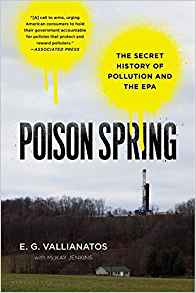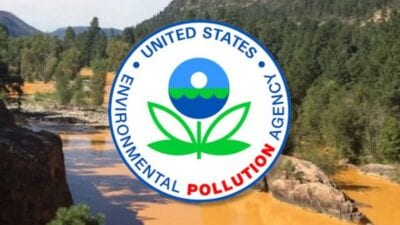The EPA, created with much fanfare by Richard Nixon in 1970, was an agency crippled at birth by inadequate funding, heavy staffing from corporate indoctrinated USDA disciples, political hypocrisy, and laws protecting industry profits above all. These understaffed and overloaded scientists rubber stamped hundreds of outdated and fraudulent pesticide studies every year resulting in further fraud and cover up in defense of bad science. FDA whistleblower scientist Adrian Gross alerted the EPA that Industrial BioTest Labs had been routinely faking tests, falsifying data, and altering results for years. Billions of pounds of pesticides lacking valid testing are sold in the US each year alone, and the active ingredient (typically 1% of product) is only the tip of the iceberg, the remainder is a trade secret stew of untested, unknown “inert” ingredients that are often more toxic than the active ingredients. Fraud, hypocrisy, cronyism, and whistleblower retribution still dominate the EPA corrupt culture today.
The lofty motto of the Environmental Protection Agency is “protecting people and the environment.” In practice, however, EPA bureaucrats faithfully protect their own people and preserve the government’s cesspool of manipulation, cover-ups, and cronyism. Here’s a video exposing the EPA’s massive military arsenal:
The EPA has an impact on every American with a tsunami of regulation that is both costly and arguably infringing on our constitutional rights. Moreover the agency has presided over an attempt to bankrupt the coal industry, close coal burning plants, and drive up to cost of motor fuels — negatively impacting job creation, the economic recovery and America’s energy security. The estimated costs of EPA regulations range from $353 billion (Competitive Enterprise Institute) to $460 billion (The American Action Forum) and are growing like a malignant cancer.
Science is the belief in the ignorance of experts,” Richard Feynman famously declared in 1966. Ever quick to challenge accepted wisdom, he distinguished the laudable ignorance of science, forever seeking unattainable certainties, from the dangerous ignorance of experts who professed such certainty. Twenty years later, he would drop a rubber ring into a glass of ice water to show a panel of clueless rocket experts how willful ignorance of basic temperature effects likely caused the Challenger shuttle disaster (1).
Experts with delusions of certainty create imitative forms of science, he warned, producing “the kind of tyranny we have today in the many institutions that have come under the influence of pseudoscientific advisors.” (2) Feynman’s warning against faith in the phony trappings of “cargo cult science” fell on deaf ears. Policies affecting every aspect of our lives are now based on dangerous forms of ignorance.
 A prime case in point is the noble edifice of the U.S. Environmental Protection Agency, where a high-ranking EPA official was recently jailed and fined for collecting pay and bonuses for decades of non-existent work while he claimed to be working elsewhere for the CIA. Such long-standing fraud would hardly come as a surprise to Evaggelos Vallianatos, who toiled for a quarter of a century in the EPA’s Pesticide Division, ostensibly responsible for protecting human health and the environment from commercial poisons. His book, Poison Spring: The Secret History of Pollution and the EPA, documents a culture of fraud and corruption infesting every corner and closet of the agency.
A prime case in point is the noble edifice of the U.S. Environmental Protection Agency, where a high-ranking EPA official was recently jailed and fined for collecting pay and bonuses for decades of non-existent work while he claimed to be working elsewhere for the CIA. Such long-standing fraud would hardly come as a surprise to Evaggelos Vallianatos, who toiled for a quarter of a century in the EPA’s Pesticide Division, ostensibly responsible for protecting human health and the environment from commercial poisons. His book, Poison Spring: The Secret History of Pollution and the EPA, documents a culture of fraud and corruption infesting every corner and closet of the agency.
Vallianatos points out that one of the fledgling agency’s greatest handicaps was its initial staffing with personnel from USDA, steeped in the religion of corporate agriculture and lethal technologies. With USDA staff came also USDA’s outdated pesticide registrations, which were to be reviewed and reregistered by EPA. In addition, hundreds of new pesticide applications accumulated every year, each supported by industry-produced safety studies to meet new federal requirements. Hired as scientists, EPA staffers spent their time cutting and pasting industry studies and conclusions into rubber-stamped registration approvals. Under industry-crafted laws, once a pesticide was registered, it could never be unregistered without massive, unequivocal evidence of harm.
As if such misuse of science weren’t bad enough, audits by FDA and EPA soon found that most of the thousands of industry safety studies used to approve pesticide registrations were fraudulent. Alerted by FDA scientist Adrian Gross, EPA had discovered in 1976 that Industrial BioTest Laboratories [IBT], which had conducted many of the pesticide safety tests submitted to EPA by manufacturers, had been routinely faking tests, falsifying data, and altering results for years. Subsequent investigations of other testing laboratories found similar practices in more than half the labs whose tests supported EPA registrations of pesticides.
“IBT was not a unique case of scientific fraud,” Vallianatos writes, “it was emblematic of a dark and deviant scientific culture, a ‘brave new science’ with deep roots throughout agribusiness, the chemical industry, universities, and the government.” (3)
In 1979, during the seven years of EPA dithering over this scandal, Vallianatos came to work at EPA. He soon learned that not a single pesticide registration was to be canceled due to fraudulent or nonexistent test data. Instead, he notes, EPA’s reaction was to outsource science. It shut down its own testing laboratories, closed its own libraries of toxicity data on thousands of chemicals, and outsourced all evaluations of industry-sponsored studies. “The unspoken understanding in this outsourcing of government functions has been the near certainty of finding industry data satisfactory – all the time.” This issue is relevant today, given that chemicals such as 2, 4-D and glyphosate (Roundup™), whose uses have been vastly increased by GMO practices, were originally registered on the basis of invalid IBT studies.
During Vallianatos’s first year at EPA, 1980, some 1.1 billion pounds of pesticide active ingredients were applied to U.S. food crops, a number that does not include home and garden uses, parklands, golf courses, playing fields, and municipal landscapes. In 2011, two billion pounds of pesticides were sold in the U.S. Most if not all of those pesticides lacked valid testing data then, and still lack such data today. Furthering the fraud, Vallianatos points out, the active ingredient is only the tip of the iceberg, being as little as one percent of the product; the remainder is a trade secret stew of untested, unknown “inert” ingredients that are often more toxic than the active ingredients. What he calls “The Big Business of Fraudulent Science” has replaced even the semblance of environmental protection.
Poison Spring chronicles some of the consequences of that fraud in an agency snared in its own tangled lies: cover-ups of dioxin levels in drinking water and in dead babies; routine suppression of data linking pesticides to soaring rates of cancer, birth defects, and chronic disease; industry access to everything; “revolving door” administrators serving corporate bosses; political appointees dismantling EPA labs and data libraries to dispose of damaging evidence; the cutting of research funds for nontoxic alternatives; the harsh retribution visited on whistleblowers; and ever and again, bureaucrats, with full knowledge of the consequences, setting policies that result in death and suffering. For 25 years, Vallianatos saw and documented it all.
“EPA officials know global chemical and agribusiness industries are manufacturing science,” Vallianatos writes. “They know their products are dangerous…. [EPA] scientists find themselves working in a roomful of funhouse mirrors, plagiarizing industry studies and cutting and pasting the findings of industry studies as their own.”
“This entire book is, in a sense, about a bureaucracy going mad,” Vallianatos adds.
Bureaucracy does not go mad by itself, however. Public indifference to the ignorance of experts and public tolerance of lies are what allow such madness to flourish, enabled by the scientific community’s silence. Inexorably, Vallianatos found, “science and policy themselves have been made a prop to the pesticides industry and agribusiness.”
Such monumental fraud demands drastic remedies, which Vallianatos bravely urges: rebuild an EPA completely independent from industry and politics, remove incentives for huge scale, chemically-dependent corporate agriculture, and address the underlying problem by encouraging small family farms and agriculture without chemical warfare.
“Traditional (and often organic) farmers – until seventy-five years ago, the only farmers there were – are slowly beginning to make a comeback. They have always known how to raise crops and livestock without industrial poisons,” Vallianatos points out. “They are the seed for a future harvest of good food, a healthy natural world, and democracy in rural America – and the world.”
These are facts, and this is a book that scientists and citizens alike ignore at great peril.
The Monsanto Papers
Investigative journalist Carey Gillam told RFK, Jr. on the “RFK Jr The Defender Podcast,” emails dating back to the 1980’s show the EPA “was working very hard to put Monsanto’s interests above the interests of public health.” An investigative journalist with 30 years experience covering food and agricultural policies and practice, Gillam said the EPA doesn’t require any independent long-term safety testing of Monsanto’s formulated Roundup products. They look only at the active ingredient glyphosate, but not the formulated product, which contains other ingredients. Scientists have found the formulations can be more dangerous because of the “enhanced synergistic effect when you mix” chemicals with surfactants, said Gillam. “The EPA still to this day doesn’t require these long-term tests on these formulated products.”1
Gilam said:
“Approximately 40% of men and women in the United States are expected to get cancer in their lifetimes, according to the National Cancer Institute. It’s just unbelievable that we are being told that we need to accept and … learn to live with cancer and get different treatments and have our body parts cut off and get radiated when we know that pesticides and chemicals and environmental toxins are big contributors to cancer.”
EPA Head Carol Browner Email and other Scandals
In 2001, former EPA head Carol Browner oversaw the destruction of her computer files on her last day in office under the Clinton administration — in clear violation of a judge’s order requiring the agency to preserve its records. Browner ordered a computer technician: “I would like my files deleted. I want you to delete my files.” In 2003, the agency was held in contempt and fined more than $300,000 in connection with another email destruction incident under Browner’s watch.
As President Obama’s energy czar, Browner went on to bully auto execs “to put nothing in writing, ever” regarding secret negotiations she orchestrated on a deal to increase federal Corporate Average Fuel Economy (CAFE) standards. She was also singled out by Obama’s own independent oil-spill commission for repeatedly misrepresenting scientists’ findings and doctoring data to justify the administration’s draconian drilling moratorium.
Browner previously had been caught by a congressional subcommittee using taxpayer funds to create and send out illegal lobbying material to more than 100 left-wing environmental organizations. She abused her office to orchestrate a political campaign by liberal groups, who turned around and attacked Republican lawmakers for supporting regulatory reform.
Below, Alex Newman of Infowars reports on the EPA’s conspiracy with the UN, the State Department & the National Security Council to control every aspect of your life using the pretense of environmentalism.
EPA Head Lisa Jackson’s ‘Richard Windsor‘ Email Scandal
The EPA chief from 2009-2013, Ms. Lisa Jackson, committed extensive violations of law that featured a fantasy administrator, ‘Richard Windsor’, and ‘his’ email account. The account was established and used by Ms. Jackson to camouflage controversial EPA processes, discussions, decisions and accountability – a persona obviously created to evade record-keeping and disclosure requirements. The known evidence suggests violations of the Freedom of Information Act, mail and wire fraud laws. For perspective a little recent history is in order. Lisa Jackson, who departed the EPA for a job at Apple in 2013, stated in November of 2011 that,
“…What EPA’s role is to do is to level the playing field so that pollution costs are not exported to the population but rather companies have to look at pollution potential of any fuel or any process or any plant or utility when their making investment decisions.”
Simply translated Ms. Jackson, a board member of he Clinton Foundation pay-for-play scheme while EPA chief, makes clear that her job and the EPA’s were to hurt companies/industries that produce energy counter to the wishes of the Obama administration (and the left’s agenda). Ms. Jackson also demonstrates a very low economic IQ, since higher costs incurred by energy companies will be passed to end users/consumers.
Due to a whistleblower and the Competitive Enterprise Institute and Christopher Horner’s investigative work a federal court (U.S. Court of Appeals for the D.C. Circuit) ruled that the EPA turn over 12,000 “Richard Windsor” emails. The EPA doesn’t produce any of the fake e-mails even though they are required by law to do so. When specifically required by court order, the EPA seeks endless delays; and, when the delaying tactics prove fruitless, the EPA then fails to provide either the number or the type of e-mails required and “who may have delayed the release dates for hot-button environmental regulations until after the Nov. 6, 2012, presidential election” according to Mark Levin and his vigilant Landmark Legal Foundation who pled to federal district judge Royce Lamberth to sanction the EPA for the cover up. Levin minced no words: “The EPA is a toxic waste dump for lawlessness and disdain for the Constitution.”
In fact, the EPA even awarded the “scholar of ethical behavior” award, among other professional recognitions, to this dude who does not exist and was created merely to unethically circumvent FOIA requests.
In addition to the ‘Richard Windsor’ email scandal, Ex-EPA Region 8 administrator James Martin appears to be the only casualty of the agency. Martin conducted business on a private email account, and then got caught lying about it before a federal court (Hillary Clinton says Hi!). He abruptly resigned (for “personal reasons”) very shortly thereafter. Chris Horner uncovered similar usage of private email accounts by EPA administrators for Regions 9 and 2. The behavior was so widespread that the Senate EPW minority staff (in the 113th Congress) wrote a report about it.
Textgate
EPA Administrator Gina McCarthy conducted business via text and then destroyed the records of her correspondence, in blatant contravention of federal recordkeeping laws. EPA’s inspector general found in December 2016 McCarthy deleted all but one of the 5,000 text messages on her government phone, in violation of federal records laws. Read a brief summary here.
In fact, the report found EPA only archived 86 of 3.1 million text messages sent and received in 2015. Investigators were only alerted to the possibility McCarthy hadn’t preserved her text messages because of a lawsuit the Competitive Enterprise Institute (CEI) filed. The “[d]efendant has decided to formally notify the National Archives and Records Administration (NARA) about the potential loss of federal records relating to text messages,” EPA admitted in court.
EPA Treatment of FOIA Requests
 The Freedom of Information Act allows citizens to petition federal agencies for information. However, not all information is subject to these requests; the statute stipulates a number of exemptions. And of these exemptions, the broadest (and, therefore, most vulnerable to abuse) is known as the “b(5)” exemption, after its statutory provision (5 U.S.C. §552(b)(5)). Indeed, Obama’s EPA has broken new ground in the application of “b(5),” such that the censor’s pen renders entire FOIA productions black. I wish I were kidding—we post the evidence here. It’s a Kafkaesque.
The Freedom of Information Act allows citizens to petition federal agencies for information. However, not all information is subject to these requests; the statute stipulates a number of exemptions. And of these exemptions, the broadest (and, therefore, most vulnerable to abuse) is known as the “b(5)” exemption, after its statutory provision (5 U.S.C. §552(b)(5)). Indeed, Obama’s EPA has broken new ground in the application of “b(5),” such that the censor’s pen renders entire FOIA productions black. I wish I were kidding—we post the evidence here. It’s a Kafkaesque.
Specifically, CEI asserts that the EPA is waiving FOIA fees for what it describes as left-wing groups – like the Sierra Club, the Natural Resources Defense Council, and EarthJustice – while it “systematically denies waivers for groups on the right,” according to CEI Senior Fellow Christopher Horner.
Horner said his research shows that from January 2012 to Spring 2013 the fees for “green” groups were waived in 75 out of 82 cases. Meanwhile, the EPA effectively or expressly denied his request for fee waivers in 14 of 15 FOIA instances over this same time period. Horner’s appeals of the EPA decisions to deny his fee waivers were rejected.
Further review, Horner said, established that “green” groups proved successful in getting their fees waived 92 percent of the time.
Sue and Settle Scam
The “Sue and settle” scam, has become a common tool of the EPA’s to impose oppressive mandates on targeted businesses with incalculable costs. To implement the scam, the EPA has an environmental or advocacy group file a suit claiming the federal government has failed to satisfy some EPA regulatory requirement. The EPA can choose to defend itself or settle the suit. The “solution” is to put in place a “court ordered regulation” requested by the advocacy group…neat, relatively fast and illegal.
Continued on next page…



